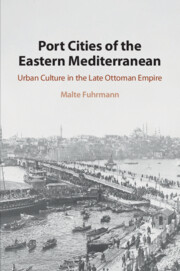Crossref Citations
This Book has been
cited by the following publications. This list is generated based on data provided by Crossref.
Sills, Charles Alton
2021.
Colonial capitalism, boundary demarcation and imperial placemaking in South Arabia.
Third World Quarterly,
Vol. 42,
Issue. 7,
p.
1644.
ADAK, Ufuk
2022.
Uluslararası İmtiyaz Mücadeleleri Bağlamında On Dokuzuncu Yüzyılda İzmir Limanı.
Alınteri Sosyal Bilimler Dergisi,
Vol. 6,
Issue. 2,
p.
145.
Sayım, Burak
2022.
Occupied Istanbul as a Cominternian Hub: Sailors, Soldiers, and Post-Imperial Networks (1918–1923).
Itinerario,
Vol. 46,
Issue. 1,
p.
128.
Toivanen, Mikko
2023.
The colonial city in motion: managing ethnic diversity through public processions in Singapore and Batavia, 1840-1870.
Asian Ethnicity,
Vol. 24,
Issue. 4,
p.
523.
Uygur, Kubra
Yalkin, Cagri
and
Uygur, Selcuk
2023.
Market-making strategies in Tanzimat era Istanbul: The quest for an elusive cosmopolitanism.
Business History,
p.
1.
Özveren, Eyüp
2023.
Mediterranean Port Cities.
p.
1.
DEMİR, Fahri
2023.
Biranın Tarihi ve Kültürel Yönü Üzerine Karşılaştırmalı Bir Değerlendirme.
Kültür Araştırmaları Dergisi,
p.
327.
Borutta, Manuel
and
Esposito, Fernando
2023.
Flüssiger Kontinent: Das Mittelmeer der Moderne.
Geschichte und Gesellschaft,
Vol. 49,
Issue. 2,
p.
163.
Olley, Jacob
2023.
An Orient of One’s Own: Music and Islamic Modernism in the Late Ottoman Empire.
Royal Musical Association Research Chronicle,
Vol. 54,
Issue. ,
p.
21.
Fuhrmann, Malte
2024.
The “veins and arteries of the country” Imagined and actual exclusion from railway connectivity in Bulgaria, 1878–1908.
The Journal of Transport History,
Vol. 45,
Issue. 3,
p.
646.
Çağlar, Burhan
2024.
Crimean War to Empire’s Fall: The English Periodicals of Late Ottoman Capital.
Media History,
Vol. 30,
Issue. 4,
p.
442.
Soysal, Funda
and
Yenen, Alp
2024.
Precarious privileges: glimpses into the post-Ottoman transition through the papers of a Salonican family.
Contemporary Levant,
Vol. 9,
Issue. 2,
p.
91.
Potamianos, Nikos
2024.
Carnival and urban space in Athens, 1834–1940.
Urban History,
Vol. 51,
Issue. 2,
p.
372.
Ekin, Umit
and
Kerim, Mehmet
2024.
An Overlooked Jewish Community: The Jews of Rodoscuk in the 17th Century.
Religions,
Vol. 15,
Issue. 9,
p.
1093.
Kerim, Mehmet
Aktaş, Furkan Mert
and
Kurt, Menderes
2024.
Community Relations in the Ottoman Balkans of the Suleymanic Age: The Case of Avlonya (1520–1568).
Religions,
Vol. 15,
Issue. 12,
p.
1443.
Reimann, Christina
2025.
Resilient forces of public amusement: the negotiation of ‘urban modernity’ in a peripheral port city (1880s–1930s).
Urban History,
p.
1.
Salvati, Luca
2025.
Economic Growth, Regional Disparities, and Urban Sprawl.
p.
25.



